Where does the index feather point?
Among the different technical arguments that i've gone trough in my long archery life, this is the one which i'm most proud of.
How many times have we found ourselves in front of one of those things which.... "it has to be done this way"... But why? "Because everyone has always used to do so"... This has always sounded like a challenge to me. Let's see if it's really like that.
We are talking about how to "nock" the arrow on the string. Having only three feathers, their position can't be symmetric to the string. One stays, usually, at 90° from a side, this feather is commonly called "index pen" or, a while ago, "the cock's feather". It usually has a different color from the other two so that it can be found as you see the arrow. (i have always preferred them all in the same color). We've always been told to keep the index feather in the opposite direction from the bow, so that the other two could be flat on the bow's window. Will this really be the right choice?
My discovery dates at 1991. We were at one of the beautiful competitions organized by the newborn FIARC (Italian bowhunting association). At the end of the competition the euphoria was still very high. So, my group and I, since we still haven't had enough of shooting, we find ourselves having a competition on a pretty long descent target. Finished the sane arrows in my quiver, i wasn't still full of it, so i decide to shoot also the last arrow which miss a feather on it, and i can't do nothing but notice that it flied better than all the other ones... just a case?
is it Possible that an arrow with the handicap of lacking something flies better than others? Only two feathers create an imbalance in the "radial symmetry" this surely can't be an advantage. The limit can be almost irrelevant but certainly not an advantage. What could be the explanation?
Knowing that the missing feather is the lower one, the one that should end up in the corner of shelf rest, between the pad and side support during the transition, the most plausible option is that the lack of its collision with the bow represents an advantage. No other hypothesis seems acceptable. In addition, the lack of this bump is such a great advantage that it shall fully compensate the lack of symmetry of the arrow in flight.
Once home the experiment has immediately begun: An arrow (soaring) with only two pens, at opposite side, another one with two pens 90 degrees one from the other and one with 4 pens. (Lighting up!) a normal arrow nocked just in opposite way! Flies great!
But how is this possible? The index feather is exactly toward the riser and should collide with the lateral support.
Then I reminded of the fact of the "paradox of the archer": The arrow, to fly straight, flexes around the arch (sliding away from it).
I token a closer look to my bow.<br >Where the arrow transits on the shelf rest there is a noticeable usury but not where we expect it to be, about more than 8mm outside (on the left for me being right shooter). (Furthermore) the feather on the bottom of each arrow is particularly ruined.
It is true that the natural feathers are extremely soft and adapt to the passage by decreasing the effect of any impact but it would seem that they have a certain negative effect.
I created this design to better view the situation: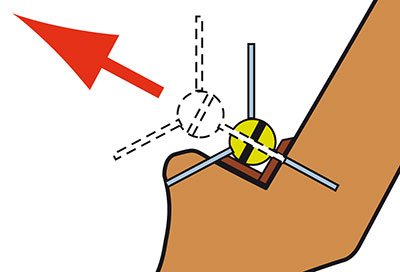
I remember that even in the longbow with which I won the World Cup in Australia in '95, the base window was so close to the best configuration of the pens was a "Y" where the lower feather is aligned to the string and the other two remained in a "V " shape upwards.
Since that time, this discovery has influenced my equipment in this way: First I started nocking the arrow in the opposite way. And this is quite easy. Secondly, the base of the window in the riser became as narrow as possible. As I drew on my PICCHIO bow and as I try to convince (with difficulties) my bowyers to modify it.
If you have a bow which has a base window wider than 10 mm, it can be reduced with a file, or if you do not want to change the bow, you can make a support of leather or other material, whide at least 3-4mm that is wide enough to hold the shaft but narrow enough to avoid any contact to the lower feather during the transition.
Let me explain: If we use a 6mm diameter shaft, it means that it touch on the mat 3mm from the side. So, a mat off 8-9mm is more than enough to hold it before falling from it. Considering that the arrow will transit the area 8-10mm on side, it means that the range of the optimum width of our support must be within 12mm to avoid to become an interference with bottom feather.
Naturally if the shaft diameter is greater measurements may vary.
Making a practical experiment like the one I described here will be easy for those who want reliable data on own situation.
Of course with the use of a REST holding the arrow the matter change completely but I’m deeply convinced the SHELF REST is the best solution for instinctive traditional shooting. From this fact follows that, by using the bow bent (as used in the instinctive shooting), a well-designed shelf rest represents the best technical solution for the shot that really has nothing to envy to any of the most hitech rest.
For all these years I have recommended this solution to all mates meet at competitions, stages, and at any event. It was really a great satisfying when, at an international gathering, I heard someone call this way of nocking the arrow "THE ITALIAN WAY".
Below pictures of the experiment with which you can verify the practical details of this argument:
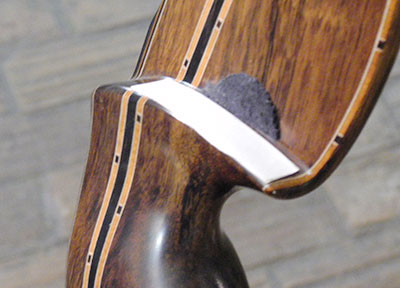 - Fig. 1. I pasted on the basis of the window of a bow a strip of drawing paper width about 15mm.
- Fig. 1. I pasted on the basis of the window of a bow a strip of drawing paper width about 15mm.
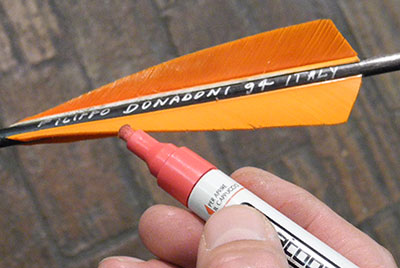 - Fig. 2. I dyed the bottom edge of the feather with a marker of red paint.
- Fig. 2. I dyed the bottom edge of the feather with a marker of red paint.
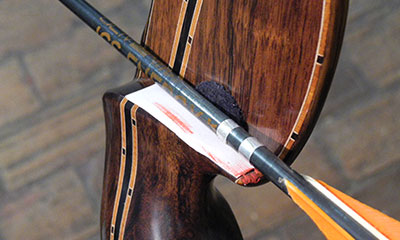 - Fig. 3. After shooting the arrow nocked the old way it is clear where the bottom feather bumped into the paper mat, 10mm outside of the point where he was placed.
- Fig. 3. After shooting the arrow nocked the old way it is clear where the bottom feather bumped into the paper mat, 10mm outside of the point where he was placed.
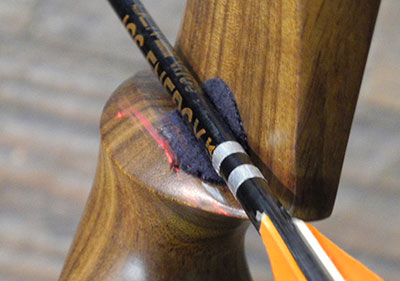 - Fig. 4. Shoot again with a PICCHIO bow which has a base window shaped as for my project and it shows that the impact was 2mm after the base window ends (this still with pen index notched outside, old way)
- Fig. 4. Shoot again with a PICCHIO bow which has a base window shaped as for my project and it shows that the impact was 2mm after the base window ends (this still with pen index notched outside, old way)
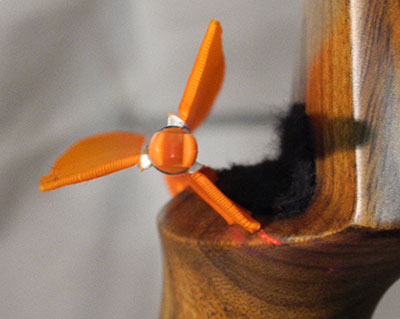 - Fig. 5. This is what happens in practice to the transit of an arrow nocked the old common way, with pen index to the outside of the arc.
- Fig. 5. This is what happens in practice to the transit of an arrow nocked the old common way, with pen index to the outside of the arc.
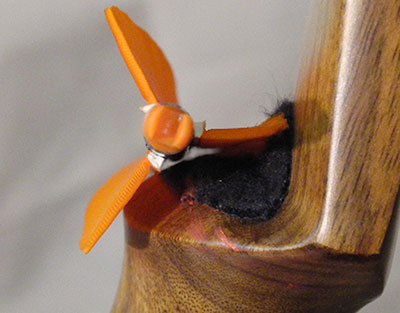 - Fig. 6. This is what happens when arrow clear on the shelf rest with arrow nocked as I recommend (with pen index towards the bow)
- Fig. 6. This is what happens when arrow clear on the shelf rest with arrow nocked as I recommend (with pen index towards the bow)


Follow us